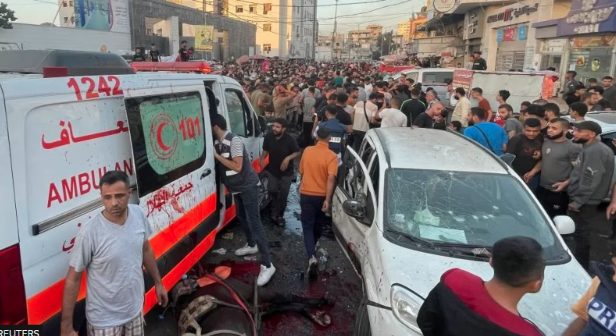Israel
Israel War Tragedy Strikes Al-Shifa Hospital in Gaza

The specter of the Israel war looms over Gaza’s narrow lanes, where the air crackles with the foreboding of further anguish, ignited by a recent devastating assault. In the throes of perpetual grief, Al-Shifa Hospital, the largest medical facility in Gaza City, has transformed from a refuge into a tableau of dread, following an attack that extinguished at least 15 lives at its very threshold. Amidst the rubble and wails, the Palestinian Red Crescent emerges as a beacon of grim testimony, chronicling this latest surge in the enduring cycle of violence that grips the region with a tight fist.
The strike, a pointed assault by Israeli forces, was on an ambulance that Israel declares was a covert vessel for Hamas militants. This claim stands starkly against a backdrop of shattered glass and torn metal, yet is proffered devoid of corroborative evidence to the global audience.
Gaza’s history is laden with the echoes of similar encounters—conflicts past that reverberate through the present landscape. This narrative, told and retold with each confrontation, now sees the Israeli military asserting a narrative of militant subterfuge, positing the grim necessity of its actions against the specter of Hamas using ambulances for purposes other than mercy.
The allegations of this grim misuse are met with fervent rebuttals, especially by those adorned with the Red Crescent, who brand the attack not merely as an offense against life but a stark breach of the Geneva Conventions. Through statements shared on various platforms, they recount the horrific sequence: the ambulance convoy was hit not once but twice—first at a distance, and then fatally at the hospital’s entrance as they sought to deliver the wounded to the threshold of hope.
The repercussions of the strike extend beyond the immediate vicinity, rippling through the region’s already precarious medical logistics, affecting the transfer of the wounded to facilities capable of advanced care, and leaving international observers and health officials in dismay. Tedros Adhanom Ghebreyesus of the World Health Organization has voiced his shock, emphasizing the inviolability of medical workers and institutions in conflict zones—a principle all too often breached.
Voices from the ground, like that of Palestinian filmmaker Bisan Owda, convey a scene of desperation and disbelief. Her words paint a vivid image of the aftermath, with makeshift encampments enveloping Al-Shifa, where inside the hospital walls, space and hope are at a premium.
The Israeli military’s strategic assessments allege that beneath Al-Shifa’s foundations lies the machinery of Hamas’s command—allegations that render the hospital grounds both a sanctuary and a target. This complexity is mirrored in the Gaza Health Ministry’s grim account of the fatalities since early October, a tally that speaks volumes of the enduring crisis.
In this grim scenario, the directives issued by Israel to seek refuge in the southern Gaza Strip resonate with a cruel irony, as those very enclaves are not spared from the barrage of strikes. The resultant exodus and return of thousands of Gazans present a haunting picture of a population caught between the hammer of advancing forces and the anvil of their besieged homeland.
The current tragedies are a continuum of a relentless saga, with Israel’s extensive bombardments following a series of attacks and hostilities that have cut deep into the nation’s psyche. These counterstrikes, in turn, contribute to an ever-tightening noose around Gaza, with Israel’s ground forces now circling the city.
Thus, the story of Gaza’s present agony is all too familiar, with its future hanging in the balance, tenuous as the ceasefires that have come and gone. The call for peace—a peace that is not merely the absence of war but the presence of justice—grows ever more urgent.
In the shadow of Al-Shifa’s shattered gates, the stories of the fallen and the cries of the bereaved rise up, challenging us to listen, to understand, and to act. The true measure of this tragedy, and of the international response it invokes, will not be found in the cold calculus of military strategy or diplomatic language. It will be measured by our collective ability to honor and protect the sanctity of life and the hallowed ground of places like Al-Shifa, where every day, the fragile boundary between life and death is navigated with tremulous hope. In the face of such profound loss, the question persists: Can we aspire to craft a narrative for Gaza that speaks of life, dignity, and peace? This is the charge history leaves us with as we bear witness to the struggle for the very soul of this ancient land.












You must be logged in to post a comment Login